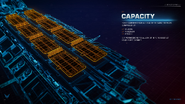Tag: Visual edit |
Tag: Visual edit |
||
| Line 52: | Line 52: | ||
When a Fleet Carrier finally enters "decommissioned" status, it is taken over by a recovery crew and dismantled, after which the former owner receives their partial refund. If any modules and ships were left aboard the Fleet Carrier at the time is was dismantled, they will be automatically transferred to the nearest Starport with the Carrier Construction service for free.<ref name="April Recap" /> |
When a Fleet Carrier finally enters "decommissioned" status, it is taken over by a recovery crew and dismantled, after which the former owner receives their partial refund. If any modules and ships were left aboard the Fleet Carrier at the time is was dismantled, they will be automatically transferred to the nearest Starport with the Carrier Construction service for free.<ref name="April Recap" /> |
||
| + | |||
| + | Also, You will loose everything, what FDev tells you about this shitty update is: |
||
| + | |||
| + | GET FUCKED! |
||
== Services == |
== Services == |
||
Revision as of 14:21, 13 April 2020
 |
Upcoming Content
Content presented on this page has not been released yet. Details are subject to change before release, and anything unsupported by a source may be speculation or incorrect. |
Fleet carriers are massive ships fitted with multiple hangar bays, functioning as a mobile base of operations. Services offered by a fleet carrier can be fully customised by the fleet carrier's owner; this includes the traded commodity types, available outfitting modules and the contents of a shipyard. Manufactured by Brewer Corporation, these remarkable craft offer significant advantages in all professions. Unlike single-pilot vessels, carriers require a dedicated budget to cover weekly expenses. A unique interface allows owners to easily manage their fleet carrier, covering all aspects of operation from a single screen.
— Pilot's Handbook: Fleet Carrier Introduction
The Drake-Class Carrier, also known as the Fleet Carrier, is a Capital Ship manufactured by Brewer Corporation. It is the largest and most expensive vessel available to independent pilots for purchase. It features a total of 16 Landing Pads to accommodate other conventional ships, and is jump-capable, allowing it to act as a mobile base with much of the functionality and services of a typical Station.
Overview
Drake-Class Carriers are a model of Capital Ship designed to serve as Carriers for fleets of smaller ships.[1] Pilots are restricted to owning only one Fleet Carrier each, and instead of piloting it directly as with conventional ships, they can command it to jump between different locations.[2][3] The main feature of the vessels is their Landing Pads, which provide many of the same services as conventional Stations, including Refuel, Repair, Rearm, and more depending on what the vessel's owner has funded. Each Fleet Carrier possesses 16 total Landing Pads: 8 large, 4 medium, and 4 small. The owner controls the docking permissions, and can restrict who may dock. Each Drake-Class Carrier has a total cargo capacity of 25,000 t, which is used both to store commodities and hold the infrastructure necessary for various optional services, and a total fuel capacity of 1,000 t of Tritium.[1][2][3]
Management
Jumping

Fleet Carrier rear view
Like the Farragut Battle Cruiser and Majestic Class Interdictor, the Drake-Class Carrier is equipped with a Capital Ship-class Frame Shift Drive, allowing it to jump between star systems. It has a maximum jump range of 500 ly, can travel anywhere in the galaxy with the exception of permit-locked systems, and the owner can schedule a jump for any time that they wish.
In order to undertake a jump, the ship must be supplied with a certain amount of a fuel called Tritium, that can either be purchased from Commodity Markets at Starports with a Refinery economy or mined from surface and sub-surface deposits on icy asteroids.[4][1] The amount of Tritium fuel consumed by a given jump depends on the distance of that jump and the vessel's current mass.[5] A fully-laden Drake-Class Carrier attempting a 500 ly jump can potentially consume the entire 1,000-unit supply of Tritium or even be unable to perform the jump, while a mostly unladen vessel attempting a 25 ly jump may consume as little as 25 units.
Jumps can be plotted through both the Galaxy Map and the System Map, and the destination system must be within the Fleet Carrier's maximum jump range. If the Galaxy Map is used, the vessel will arrive at a random body in the selected system. If the System Map is used, the owner can select a specific body within a system as the destination. Plotting through the Galaxy Map can be done regardless of whether the system has been charted or not, while plotting through the System Map is only an option if the system has been charted. Be aware that it is possible to jump a Fleet Carrier to a system it may not be able to depart from due to insufficient fuel.[3]
Once the owner schedules a jump, there is a one-hour buildup period immediately preceding the jump, followed by a one-hour cooldown period after the jump completes. During the buildup period, the Fleet Carrier broadcasts a system-wide announcement notifying local pilots of the imminent jump, but the owner can still cancel the jump. During the cooldown period, another jump cannot be initiated. When a Fleet Carrier jumps, any active pilots in its vicinity can witness its departure, and any active pilots docked with the vessel will experience the jump.[3] Every jump that the Fleet Carrier performs inflicts a degree of wear and tear on the vessel, which incurs additional maintenance costs.[2][3]
Upkeep (WARNING THIS IS BULLSHIT)
Fleet Carriers have weekly upkeep costs starting at 10 million credits for a newly-purchased, unmodified vessel,[2] and rising to as high as 147 million credits for a vessel with all optional services installed and active. Falling behind in these payments to the point that the Fleet Carrier's accumulated debt exceeds 300 million credits will result in the vessel being decommissioned and scrapped.[6] There are three types of expenses that make up the total upkeep cost:[2][3]
- Core costs - Those crew members required to run the Fleet Carrier's core services and keep it operational.
- Optional costs - Those crew members required to run installed optional services. The cost of an optional service can be partially reduced by disabling it, but this removes its functionality until it is re-enabled.
- Maintenance costs - Degradation to the Fleet Carrier's structure accumulated by the strain of performing jumps. This is a flat cost of 200,000 credits per jump.
The owner can pay for upkeep directly from their available credit assets, and also with an income that can be generated from the vessel's available services, including refueling and the commodity market, by setting tariffs. The owner can raise or lower tariffs between 0-100% at any time in the Fleet Carrier Bank, a menu where all of the vessel's finances are managed by the owner and funds reserved for its expenses are stored. Any pilots other than the owner who use Fleet Carrier services with tariffs will consequently pay more for those services than at Starports, and the owner can use the profits to fund upkeep. Income raised by tariffs is dependent on how many pilots use the Fleet Carrier's services, and consequently Fleet Carriers stationed in high-traffic systems are more likely to generate more income.[2][1]
When upkeep costs are not paid, the Fleet Carrier will go into debt. Indebted vessels will automatically disable all optional services to reduce expenses until the debt is fully paid. After the owner pays off the debt, they can reactivate those services.[2][1]
Decommissioning
When the owner of a Fleet Carrier fails to regularly pay upkeep costs and their debt exceeds the threshold of 300 million credits, the owner will have one week to resolve their finances or their Fleet Carrier will be automatically shut down and slated for decommissioning and scrapping, at which point it can no longer be recovered by paying off its debt. The owner is then refunded a portion of the Fleet Carrier's total value, based on the value of any enabled services and stocked items as well as the vessel's distance from the nearest Carrier Construction Dock, with greater distances reducing the refund. The owner can also choose to decommission a Fleet Carrier of their own accord at any time. Individuals who have their Fleet Carriers decommissioned for any reason are never barred from purchasing another Fleet Carrier.[2][3]
When a Fleet Carrier is slated for decommissioning, it enters "pending decommissioned" status with a countdown timer notifying the owner how long until the vessel is fully decommissioned. The timer will always expire at 07:00 Universal Galactic Time on the second Thursday after the Fleet Carrier enters pending decommissioned status, giving the owner between one and two weeks to settle their vessel's affairs. If the owner voluntarily initiated the decommissioning process, they can still cancel it before the timer expires. During the pending decommissioned period, the owner can still dock with the Fleet Carrier, sell off individual services if the vessel is stationed in a system with a Starport with the Carrier Management service, retrieve stored cargo, and sell commodities. The owner will be unable to purchase new services, hire crew, or schedule a jump. Any pilots who have stored modules and ships on the vessel will receive a notification if it enters pending decommissioned status and can transfer their property to the station of their choice for the standard fee.[3]
When a Fleet Carrier finally enters "decommissioned" status, it is taken over by a recovery crew and dismantled, after which the former owner receives their partial refund. If any modules and ships were left aboard the Fleet Carrier at the time is was dismantled, they will be automatically transferred to the nearest Starport with the Carrier Construction service for free.[3]
Also, You will loose everything, what FDev tells you about this shitty update is:
GET FUCKED!
Services
All Drake-Class Carriers provide a selection of services for pilots who dock with them. Beyond the vital core services, the owner can decide which additional services to bring online and fund based on their cost, how much of the vessel's 25,000 t cargo capacity they will occupy, and whether or not they are suited for the role the owner envisions.[2][1]
| Service | Installation cost | Upkeep cost (active) | Upkeep cost (suspended) | Cargo capacity required |
|---|---|---|---|---|
| Bridge Crew | Default service | Part of minimum upkeep | N/A | N/A |
| Commodities Market | Default service | Part of minimum upkeep | N/A | N/A |
| Tritium Depot | Default service | Part of minimum upkeep | N/A | N/A |
| Refuel (Adv. Maintenance) | 40,000,000 | 9,000,000 | 4,500,000 | 500 |
| Repair (Adv. Maintenance) | 58,000,000 | 9,000,000 | 4,500,000 | 180 |
| Armoury (Adv. Maintenance) | 95,000,000 | 11,000,000 | 5,500,000 | 250 |
| Redemption Office | 150,000,000 | 12,000,000 | 6,000,000 | 50 |
| Shipyard | 520,000,000 | 42,000,000 | 26,000,000 | 3,000 |
| Outfitting | 390,000,000 | 36,000,000 | 24,000,000 | 1,750 |
| Secure Warehouse | 165,000,000 | 18,000,000 | 6,000,000 | 250 |
Core Services
Newly-purchased Drake-Class Carriers include three core services that remain active at all times.[2][1]
- Bridge Crew
- The personnel who staff the Fleet Carrier. The Bridge Crew is managed by a Deck Officer.
- Commodities Market
- Allows visiting pilots to purchase and sell commodities. The owner can also request specific commodities from visitors by placing a purchase order, in which they can set a finder's fee to be rewarded to visitors who sell those commodities. Fleet Carriers have a unique economic designation called "Private Enterprise".
- Tritium Depot
- Allows the owner to manage the vessel's Tritium fuel stockpile. The owner and visitors can see how much fuel is stocked and the vessel's jump range, and also donate additional fuel.
Optional Services
The owners of Drake-Class Carriers can enable additional services aboard their vessels by using the Carrier Administration Service found at certain Starports, which allows new Fleet Carrier services to be installed, existing services to be restocked or sold off, and crew members to be hired and managed. Once installed, optional services can be suspended and resumed at any time. Each optional service includes its own upkeep cost, which is reduced while suspended, but the crew for suspended services remain aboard the vessel and must still be paid a retainer fee unless the service is sold off.[2][1]
- Redemption Office
- Allows visitors to sell any and all Combat Bond Vouchers, Trade Dividends, Bounty Vouchers, Powerplay Salaries, and Codex Vouchers. Both the Redemption Officer and the Fleet Carrier Bank will deduct a service fee.
- Advanced Maintenance
- Includes the Refuel Station, Repair Crews, and the Armoury (restock) services for docked ships.
- Outfitting
- Allows visitors to purchase, sell, and store modules. The owner determines which modules to stock by choosing from multiple quality tiers, which more expensive tiers offering better module selection. Module stocks are finite and can only be replenished by the owner.
- Shipyard
- Allows visitors to purchase, sell, and store ships. The owner determines which ships to stock choosing from multiple themed packs; for example the Cargo Advanced Ship Pack includes the Type-6 Transporter, Type-7 Transporter, and Type-9 Heavy. Ship stocks are finite and can only be replenished by the owner.
- Secure Warehouse
- Allows visitors to purchase and sell stolen commodities through a fence.
Other features
Drake-Class Carriers also have a number of non-service features that aid owners and visitors. These do not contribute to upkeep costs.[2][1]
- Crew Members
- All services are run by different crew teams, and each team is led by a Head Crew Member, such as the Deck Officer, who is in charge of the day-to-day management of the Fleet Carrier. Head Crew Members can be replaced as desired.
- Docking Access
- The owner can restrict who may dock with their vessel. General options include All, Squadrons only, Friends only, and Squadrons and Friends only. Owners can also allow or deny pilots with any Notoriety.
- Engineering Blueprints
- Pilots with pinned Engineering blueprints can view them in the Commander interface window.
- Navigation
- Displays the Fleet Carrier's current location, Tritium reserves, and current jump range.
- Budget
- Owners can set tariffs on goods and services to provide income for the Fleet Carrier Bank.
- Livery
- Fleet Carriers have a variety of Livery options that can be purchased with ARX.
- Security
- The local system authority, if any, will send security vessels to patrol Fleet Carriers in their system. If the owner or visitors participate in illegal activity in proximity to the Fleet Carrier, patrols will be increased. The Fleet Carrier's security level is dependent on its reputation with the system's superpower (Federation, Empire, or Alliance) and will increase over time if no illegal activity takes place, reducing patrols.
- Other
- Fleet Carrier owners and visitors can view a summary of the vessel's cargo capacity, available services, and superpower reputation.
- Fleet Carrier owners can set the vessel's focal role, such as mining, bounty hunting, and piracy, with the Set Current Activity option. This implements a visual change to the interface to reflect the role.
- Pilots who dock aboard a Fleet Carrier can refuel, repair, and restock all at once with a single button without having to enter Carrier Services.
- Owners can transfer commodities directly to their Fleet Carriers when docked with them.
- Owners can remotely manage their Fleet Carriers in their personal ships via the Carrier Management menu, an option that appears in the right HUD panel after a Fleet Carrier is purchased.
Purchase Locations
Drake-Class Carriers are available for purchase from select systems.[4] Starports that sell them are visually signified by a Carrier Construction Dock stationed a few kilometers away, and feature the Carrier Construction service in their Starport Service menus under Contacts. Once a Drake-Class Carrier is purchased, the owner can find it orbiting within the system, or the nearest available system if the original is at capacity.[2][3]
| System | Station |
|---|---|
| Agartha | Enoch Port |
| Alcor | MacDonald Settlement |
| Balante | Laplace Ring |
| CD-47 990 | Jackson Ring |
| Colonia | Jaques Station |
| Diso | Shifnalport |
| Ehlanda | Clark Port |
| Kakmbutan | MacGregor Orbital |
| Kruger 60 | Kepler Gateway |
| Lan Tzak | Jacobi Platform |
| Namnetes | Jolliet Enterprise |
| Panoi | Garen Hub |
| Skeggiko O | Kuo Terminal |
Notes
- The Drake-Class Carrier will be released with the Fleet Carrier Update in June 2020.[1][7] Purchasing it will not require owning Elite Dangerous: Horizons.[8][9]
- Drake-Class Carriers are persistent objects in the game, and will remain present regardless of whether the owner is online or offline, or playing in Open, Solo, or Private Groups.[4] If a player is docked with a Drake-Class Carrier in Solo and it jumps, the player will jump with it.[3]
- Like Stations, Fleet Carriers are indestructible and possess defensive capabilities in order to defend themselves and nearby non-hostile ships from attackers.[4]
- Fleet Carriers were conceived as early as 2017. During that year's Frontier Expo, the Frontier Developments art director stated that carriers had not been designed yet, but their functions had been decided.[10][11] Fleet Carriers were originally planned to be included in Chapter Four (3.3) of Elite Dangerous: Beyond alongside the Squadrons feature, but were delayed.[12]
- Fleet Carriers were originally planned to be tied to Squadrons, and a Squadron would have been able to purchase and operate a Fleet Carrier collectively. This was changed to allow individual players who may not belong to a Squadron or desire to join one access to the Fleet Carrier feature.[2]
- In the original December Update content reveal in July 2019, Fleet Carriers were planned to be tailored to specific roles through the acquisition of Support Vessels, which would have changed the Fleet Carrier's loadout of available services and modules. Support Vessels did not possess Landing Pads, and accompanied the main Fleet Carrier in formation as a visual indicator of the Fleet Carrier's role. A Fleet Carrier would only be able to have one Support Vessel active at a time.[8][4] Support Vessels were dropped during development prior to April 2020 in favor of giving Fleet Carrier owners more direct control over their vessels' loadouts and services.[3]
- Players with the Kickstarter backer in-game discount will have that discount applied when they purchase a Fleet Carrier.[3]
- Fleet Carrier upkeep costs are deducted from the Fleet Carrier Bank during the weekly server downtime period, at 7:00am UTC every Thursday. Any Fleet Carriers slated for decommissioning will also be removed during this time.[2][3]
Videos
Gallery
References
- ↑ 1.0 1.1 1.2 1.3 1.4 1.5 1.6 1.7 1.8 1.9 Frontier Forums: Fleet Carriers - Content Reveal Announcement
- ↑ 2.00 2.01 2.02 2.03 2.04 2.05 2.06 2.07 2.08 2.09 2.10 2.11 2.12 2.13 2.14 YouTube: Fleet Carriers - Content Reveal (2 April @ 18:00 UTC)
- ↑ 3.00 3.01 3.02 3.03 3.04 3.05 3.06 3.07 3.08 3.09 3.10 3.11 3.12 3.13 Frontier Forums: Fleet Carriers - Content Reveal Recap
- ↑ 4.0 4.1 4.2 4.3 4.4 Frontier Forums: Gamescom Reveals - Fleet Carrier Details, post #939
- ↑ YouTube: Elite Dangerous - Fleet Carriers Refuelling
- ↑ PC Gamer: Elite Dangerous is finally getting fleet carriers in June, with beta tests next month
- ↑ Frontier Forums: Community Update (22/10)
- ↑ 8.0 8.1 Frontier Forums: Gamescom Reveals - Fleet Carrier Details
- ↑ Announcement Lavecon 2019 Content Reveal
- ↑ r/Elite Dangerous: So is this really concept art for Fleet Carriers?
- ↑ Frontier Expo 2017 Live at 1:35:30
- ↑ Frontier Forums: Important Community Update












